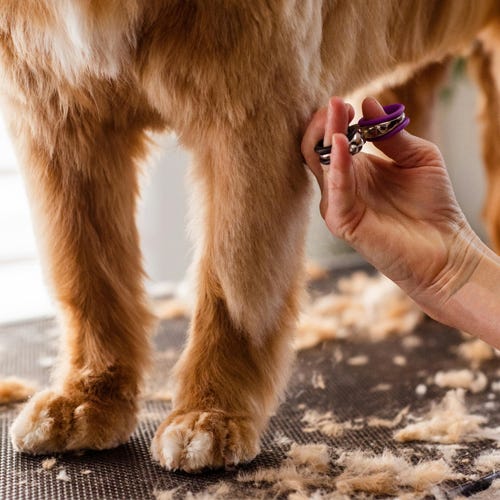What Makes Flea & Tick Products Work?
07/08/2014
Insecticides found in flea and tick control products come in three forms: carbamates, organophosphates and botanicals. Carbamates and organophosphates are manmade pesticides containing carbon, hydrogen and phosphorus. They are effective against a wide variety of insects, including fleas and ticks, and are commercially available as ready-to-use solutions, emulsifiable concentrates, dips, dusts, baits, pest strips and collars. Some common names of these insecticides are Propoxur, Diazinon, Malathion, and Proban. They have a very quick knock-down (killing) ability. Depending on the application method, the residual effect can be as long as 45 days. Some brand names containing these types of pesticides are Baygon, Sevin, and Rabon.
Care should be used in applying carbamates and organophosphates, as they inhibit cholinesterase. Cholinesterase is an enzyme found in mammals that helps regulate the activity of nerve impulses. If these compounds are used too frequently, in too high a dosage, or in combination with each other, they can cause nerve responses to slow down in animals and humans. Be sure you read the label on each product, because the effects can be cumulative, especially if you are combining an impregnated collar with powders, sprays or long-lasting dips. Also it is vital to determine which animals it is safe to use it on. Many are unsafe for cats, kittens and puppies, but are suitable for healthy adult dogs.
Symptoms of overexposure include depression, increased salivation, staggering gait, frequent urination, vomiting, diarrhea, respiratory distress, shaking, convulsions, coma, and death. Although the above symptoms appear to be in order of sensitivity, an animal may progress from mild symptoms to coma and death in a matter of minutes, depending on the severity of the overdose. As soon as an overdose of organophosphates is suspected, the animal should be taken to a veterinarian. If there is an unavoidable delay in obtaining medical care, the animal should be bathed thoroughly in order to remove as much insecticide as possible. Groomers who may be using these insecticides frequently should protect themselves with waterproof gloves, smocks and/or sleeves to avoid absorption through the skin. In case of skin contact, wash thoroughly with soap and water.
Botanicals are derived from a natural plant source and are used as an insecticide in their natural state. Natural pyrethrins come from pyrethrum flowers, one of which is the African Chrysanthemum. Pyrethrin begins to break down and disappear as soon as it is exposed to ultraviolet light, so is extremely safe to use. It will not build up in the soil or percolate down into the groundwater. It is usually combined with a binding compound. The binding compounds are non-toxic to insects if used alone, but increase the knock-down ability and increase the activity time (up to four days) of the pyrethrins when combined with them. Two common binding compounds found listed in a product's ingredients are Piperonyl Butoxide (PBO) and N-Octyl Bicyclopheptene Dicarboxmide (MGK264). Pyrethrin-based products may be labeled for dogs or for dogs and cats, depending on the percentage of insecticide in the product. They can be used as often as necessary, and offer almost instant killing ability. They also cause few adverse affects when combined with each other and with organophosphates or carbamates.
Synthetic pyrethrins are botanicals that have been modified to make them more stable than natural pyrethrins, so they do not break down when exposed to sunlight. This class of insecticide includes Permethrin, Resmethrin, and Allethrin. Synthetic pyrethrins are much like natural pyrethrins, but have a slightly slower knock-down time. To offset this drawback, they have up to a 14 day residual effect and do not need to be applied as often. Therefore, you will sometimes find products containing both natural pyrethrin (for quick killing action) and synthetic pyrethrin (to repel insects for up to 14 days). These also may be labeled dog only, or dog and cat, depending on the percentage of insecticide.
Pyrethrins, both natural and synthetic, will kill almost all species of insects. One exception however is the mange mite. Because mange mites are difficult to diagnose, and may burrow under the skin, they are one of the hardest infestations to eliminate. Topical products applied to the skin surface cannot reach the mite infestation, thus rendering them useless against mange. Assistance from a veterinarian is imperative when such an infestation occurs.
A relatively recent development in the battle against fleas and ticks is the Insect Growth Regulator (IGR). This is not an insecticide, but a synthetic substance that prevents the insect's eggs from developing and hatching. Some IGR’s have the ability to migrate around the premises, so as the animal moves around the home, the IGR is spread to many of the surfaces. This is very useful in that it protects homes that do not have any fleas or ticks from experiencing a population explosion caused by a stray female riding in on the owner's shoe. Methoprene, an IGR, lasts for about 210 days and is of the migrating variety. Another called Fenoxycarb does not migrate, but it lasts 365 days on areas where it is applied. IGRs are frequently combined with pyrethrins in the topical products like Bio Spot. The cat versions of these topicals are only an IGR, so a separate product must be used if adult fleas are present. Bio Spot includes pyrethrin towelettes with its product, Bio Spot for cats.
There are other alternatives for flea and tick control. D'Limonene, citrus oil derived from orange peel, is added to many shampoos such as Citrilux; and is the active ingredient in some dips and sprays. Linalool and citronella are also citrus derivatives, similar to D'Limonene. Eucalyptus oil, pennyroyal and cedar oil also may have some flea repellent properties, as long as the fragrance is present on the animal. An added benefit of using these natural products is that they are very soothing to the skin in cases of fleabite dermatitis. Aromatic wood shavings, used as filling in many pet cushions, also have repellent properties. There is some evidence that garlic and brewer's yeast also repel fleas by giving the animal's blood a disagreeable taste. This is due to the high level of B vitamin complex contained in yeast and the flavor of the garlic. It does not work in all dogs at all times, but may be worth trying if the owner wishes to use an all-natural insect repellent program.






